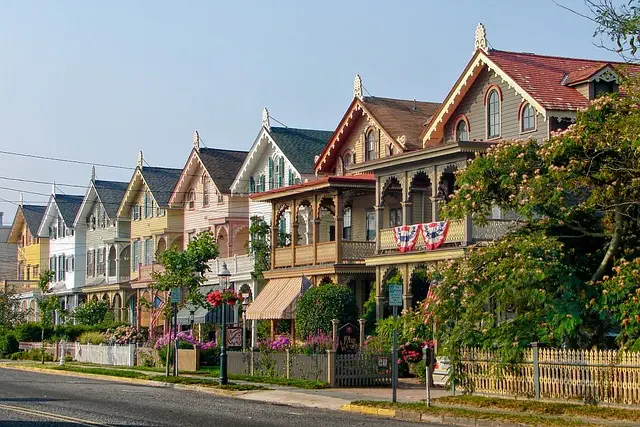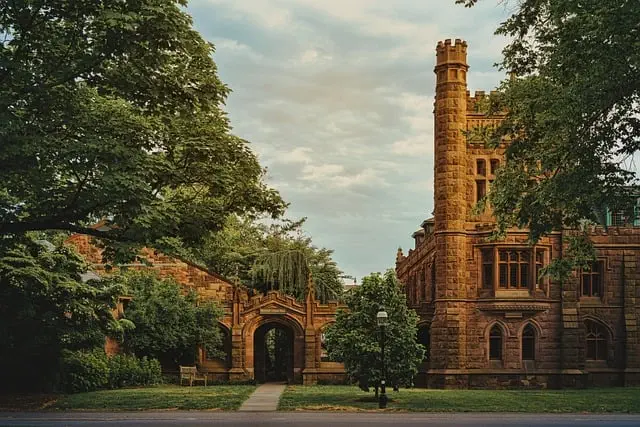2023 heralds Cape May County, New Jersey, as a multifaceted destination rich in history, culture, and natural beauty. With a heritage dating from 1687, the county offers a glimpse into American history with landmarks like the Cape May Lighthouse and the expansive Cape May County Zoo. The area's architectural legacy is preserved in the Historic District of Cape May, while the Cape May National Wildlife Refuge and Cape May Point State Park provide critical habitats for over 350 bird species, including the red knot, and are central to conservation efforts. The county's commitment to preserving its historical assets and ecological sites ensures that visitors can engage with both the past and the present, making it a dynamic year-round destination for nature lovers, history buffs, and beach enthusiasts alike. Cape May County's maritime legacy is evident in its underwater archaeological sites and iconic lighthouses, which add to its allure as a unique coastal escape in New Jersey.
Discover the enchanting allure of Cape May, New Jersey, a destination rich in history, brimming with natural beauty, and boasting an architectural charm that rivals its scenic landscapes. Delve into the pages of this article to explore the multifaceted wonders of Cape May County, from its storied past to the vibrant ecosystems and unique maritime legacies submerged off its shores. As a birdwatcher’s utopia, witness the spectacle of migratory patterns and rare species that attract enthusiasts year-round. Each season in Cape May County unveils a new layer of its allure, inviting you to experience its seasonal splendor and the timeless appeal of its historic villages. Join us on this journey through the diverse offerings of Cape May County, New Jersey, where history, nature, and architecture converge to create an unforgettable destination.
- Exploring the Rich History of Cape May County, New Jersey
- Natural Wonders and Wildlife Sanctuaries: A Glimpse into Cape May's Ecosystem
- Cape May's Architectural Heritage: A Stroll Through Historic Villages
- Birdwatching Paradise: The Migratory Patterns and Rare Species of the Cape May Area
- Uncovering the Maritime Past: Shipwrecks and Lighthouses Off the Coast of New Jersey
- Seasonal Splendor: Experiencing the Charm of Cape May County Year-Round
Exploring the Rich History of Cape May County, New Jersey

Cape May County, New Jersey, is a region steeped in history, with a narrative that stretches back to its founding in 1687. As one of the nation’s oldest settlements, it has served as a pivotal point in American history, from its role during the Revolutionary War and its status as a significant port to its transformation into a premier coastal destination. The county’s historical significance is evident in its array of museums, including the Cape May Lighthouse, which has stood as a beacon since 1823, and the Cape May County Zoo, one of the largest zoological parks in the United States. History enthusiasts can immerse themselves in the past by exploring the preserved Victorian-era homes, such as the Emlen Physick Estate, which offers a glimpse into the lifestyles of the county’s affluent 19th-century residents. Beyond its historical landmarks, Cape May County is also recognized for its role in the early aviation era, with the Cape May Airport being an original stop for pioneering flights. The county’s rich tapestry of history is complemented by its commitment to preserving these sites for both locals and visitors to appreciate.
Natural Wonders and Wildlife Sanctuaries: A Glimpse into Cape May's Ecosystem

Cape May, located at the southernmost tip of New Jersey, is a haven for natural wonders and wildlife sanctuaries that showcase the region’s diverse ecosystems. The area, part of Cape May County, boasts the Cape May National Wildlife Refuge, a critical habitat for over 350 species of birds, including the iconic red knot, and a variety of other wildlife. This refuge, spanning more than 10,000 acres, offers visitors opportunities to observe and appreciate the natural beauty and biodiversity of the region through its network of trails and observation areas. The delicate balance of this ecological treasure is further protected by the efforts of conservationists and environmental agencies, ensuring that the vibrant flora and fauna remain intact for generations to come.
Adjacent to the refuge lies the Cape May Point State Park, a significant landmark within Cape May County, New Jersey. This park’s diverse habitats range from maritime forests to freshwater marshes, attracting birdwatchers, naturalists, and eco-tourists year-round. The “Cape May Raptor Banding Project,” conducted here, is a unique initiative that allows visitors to witness the fascinating process of monitoring and protecting birds of prey. Additionally, the park’s lighthouse, standing as a beacon since 1823, offers panoramic views of the Atlantic Ocean and Delaware Bay, adding an element of historical significance to the natural splendor of this area. Together, these protected lands in Cape May County serve as essential ecological hubs and offer a glimpse into the rich and varied ecosystems that thrive within New Jersey’s most southern point.
Cape May's Architectural Heritage: A Stroll Through Historic Villages

Cape May, a charming locale in Cape May County, New Jersey, is renowned for its architectural heritage that spans several centuries. A leisurely stroll through its historic villages offers a glimpse into America’s past, with a variety of structures that range from the Gothic Revival to the Queen Anne style. The Cape May Historic District, a National Historic Landmark, encompasses over 750 well-preserved buildings, each telling a story of a bygone era. Visitors can admire the intricate woodwork, grand fireplaces, and the elegant facades that have withstood the test of time. The Cape May County Historical & Genealogical Society Museum provides further insight into the region’s rich history, making it an essential stop for those captivated by architectural marvels and the stories they hold. The county’s commitment to preserving these treasures ensures that their architectural legacy endures, offering a window into the lives of those who came before us and the cultural evolution of the region. Exploring Cape May’s historic villages is not just a walk through picturesque streets; it’s an immersive journey back in time that highlights the significance of this area within the broader historical narrative of New Jersey.
Birdwatching Paradise: The Migratory Patterns and Rare Species of the Cape May Area

Cape May, located at the southernmost tip of New Jersey, is a haven for birdwatchers and nature enthusiasts, renowned for its exceptional biodiversity and the migratory patterns of birds that pass through. This area, part of Cape May County, plays a pivotal role in the annual migration of avian species along the Atlantic Flyway. The unique geographical position and varied ecosystems within the region make it an ideal stopping point for birds traveling long distances.
The region’s diverse habitats—including marshes, bays, and coastal woodlands—provide critical resources for a plethora of bird species. Cape May County, New Jersey, is particularly famous for its sightings of rare and hard-to-spot migratory birds, such as the Cape May Warbler and the Cerulean Warbler. The area’s extensive network of nature reserves, like the Cape May Point State Park and the Migratory Bird Sanctuary, protect these species and offer visitors unparalleled opportunities to observe them in their natural settings. These protected areas are vital not only for conservation but also for research and education, contributing significantly to the understanding of migratory patterns and avian ecology. Birdwatchers from around the globe flock to Cape May County, New Jersey, to witness the extraordinary spectacle of bird migration and to add to their life lists some of the most beautiful and elusive birds found in North America.
Uncovering the Maritime Past: Shipwrecks and Lighthouses Off the Coast of New Jersey

Cape May County, New Jersey, is a region steeped in maritime history, with its coastline harboring a wealth of underwater treasures and navigational landmarks that tell tales of eras long past. The waters off Cape May are not just a passage for modern marine traffic but also a final resting place for numerous shipwrecks, each telling a story of the area’s significant role in maritime commerce and defense. These sunken vessels, some dating back to the 17th century, provide an intriguing glimpse into the past, offering divers and underwater archaeologists a chance to explore and conserve a part of history that has lay undisturbed on the ocean floor.
The county’s maritime legacy is further celebrated through its iconic lighthouses, standing as silent sentinels guiding ships safely to shore. Among these, the Cape May Lighthouse, standing at 157 feet tall, is one of the most famous and well-preserved lighthouses in the United States. It has stood since 1879, its striking red and white stripes a beacon for those at sea. The lighthouses of Cape May County are not just monuments to navigation; they are landmarks that have shaped the region’s identity, attracting visitors from around the world to ascend their steps and take in the breathtaking panoramic views of the Atlantic coastline. Together, the shipwrecks and lighthouses off the coast of New Jersey form a crucial part of Cape May County’s historical tapestry, offering a unique blend of adventure, education, and heritage for all to appreciate.
Seasonal Splendor: Experiencing the Charm of Cape May County Year-Round

Cape May County, nestled in the southernmost tip of New Jersey, offers a diverse array of experiences throughout the year that captivate visitors and locals alike. The charm of this region is not confined to any single season; it unfolds with each change in weather and temperature. In spring, the county welcomes blooming flora and migratory birds, painting a vibrant picture of rebirth and vitality. The Lighthouse Beach and Sunset Beach provide idyllic backdrops for leisurely strolls, while wildlife enthusiasts flock to the Cape May Point State Natural Landmark to witness the convergence of diverse habitats teeming with life.
As summer unfolds, Cape May County becomes a haven for beachgoers and outdoor adventurers. The pristine beaches along the Atlantic shore offer opportunities for sunbathing, swimming, and an array of water sports. Meanwhile, the historic town of Cape May invites visitors to explore its 19th-century architecture and charming boutiques. The Cape May County Zoo, one of the largest in the United States, provides a day of family fun and education, featuring animals from around the globe. Come autumn, the area transitions into a picturesque tableau of fall foliage, with the Jersey Pine Barrens providing a unique landscape of pine forests and freshwater wetlands. The cooler months bring their own charm, as Cape May County becomes a winter wonderland, perfect for snow sports and cozy getaways. Throughout each season, the county’s rich history, cultural heritage, and natural beauty make it an alluring destination for travelers seeking to experience the splendor of New Jersey year-round.



